Joyful Trains
A “Joyful Train” is a trainset intended for charter use, often for corporate trips to resorts. These may be self-propelled (EMU or DMU sets) or passenger cars with an accompanying locomotive. Some of the self-propelled EMU sets are equipped with generators enabling them to be locomotive-hauled for use on non-electrified lines.
Locomotive-hauled passenger cars had been used to form Joyful Trains since 1961, according to wikipedia. The first self-propelled Joyful Train was (I believe) the original Nanohana, a DC-powered EMU introduced in 1986. This was followed by a multitude of DC and multi-voltage EMUs and DMUs over the next fifteen years, as the various JR companies repurposed older equipment for lucrative charter service during the boom years of the so-called “bubble economy”. Japanese Wikipedia reports that the use of Joyful Trains has decreased since the collapse of the economic bubble, with more use being made of bus travel for chartered trips.
According to the above Japanese Wikipedia, JR East uses the term somewhat generically to mean any train that has a unique or different exterior and/or interior, and not just for trains used in charter service.
Starting with (I think) the Utage in 1994, 485 Series trainsets were used as the basis for new Joyful Trains. The 485 series was introduced in 1968 (or perhaps 1972), and operated by several JR companies, including JR East. The train is a dual-voltage design, and can operate on either 1500 Volt DC or 20,000 Volt AC (the latter at 50 or 60 Hz), and is capable of a top speed of 140 kph.
Although other EMU’s have been used for Joyful Trains, the 485 Series has been used for the bulk of them, as its dual-voltage dual-frequency design provides a train that can go nearly anywhere, particularly if equipped with a small generator for light and heat, allowing the train to be loco-hauled on non-electrified lines.
DMU-based Joyful Trains are more diverse, with trains based on the KiHa 48, 58, 71, 72, 140/147, and 183-5x00 series equipment. Almost all of those still operated by JR East are based on the KiHa 48. As these typically operate far from Tōkyō, they have been omitted from this page, at least for now.
However, one defining characteristic of the Joyful Train is that they typically look very little like the original equipment, having been heavily rebuilt inside and out. This is perhaps less true of some of the DMU versions, but the EMUs look little like a typical 485.
Types of Joyful Trains
Many of the Joyful Trains have traditional tatami mat floors and seats that are essentially cushions with backs, for sitting directly on the floor. This reflects a traditional kind of furniture found in many resorts. Others have more European arrangements, with carpeted floors and upright seats; these are known as “carpet trains”. And some appear to have ordinary railroad passenger seating (fixed seats that can recline).
In Google translations of Japanese pages, the tatami-mat trains are colorfully described as “car squat” trains or as a “squat train” (和式列車), but I have described them here as “tatami-mat trains”.
Salon Express Tōkyō (Loco-Hauled, European)
The Salon Express Tōkyō, abbreviated SET, was a European-style loco-hauled set of 14-series passenger cars, operated out of Shinagawa depot in Tōkyō. Originally built in 1983, it was retired in 1997 and (according to the Japanese Wikipedia Joyful Trains article) at least some of the cars were converted to be part of the Tatami-style "Sado Salon" Joyful train, but this only lasted until 2002. However, it would appear that something lived on as the Tatami-style Yutori Joyful Train using the same cars until 2008.
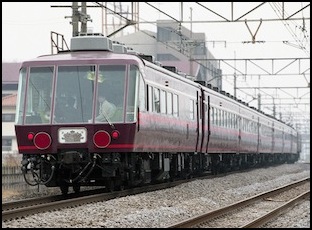
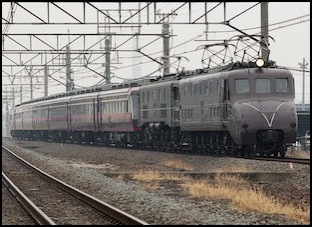
Salon Express Tōkyō (unknown date), and SET hauled by EF55 #1 and EF58 #61 (unknown)
Photographer: spaceaero2 (both)
Yutori (Loco-Hauled, Tatami)
I haven't been able to find out much about the Yutori (ゆとり, meaning relaxed), except that it appears to be a descendant of the Salon Express Tōkyō, either directly or via the intermediate Sado Salon train. Externally it appears identical to the Salon Express Tōkyō, but internally it has been converted to Tatami-style seating. There's a small write-up at the end of the Japanese Wikipedia Salon Express Tōkyō entry. Operation of this train ended in 2008.
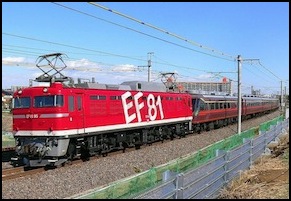
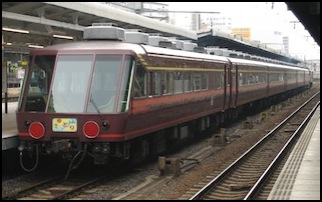
EF81-95 pulling Yutori (2007), and Yutori (2006)
Photographers: まも (Mamo), and 継之助 (Tsuginosuke)
Super Express Rainbow (Loco-Hauled, Conventional Seating?)
The Super Express Rainbow was a loco-hauled set of 12- and 14-series passenger cars, operated out of Oku depot in Tōkyō. Originally built in 1987, it was retired in 2000. Two locomotives were painted red to match this train, see the EF65 entry on the Passenger Locomotives page.
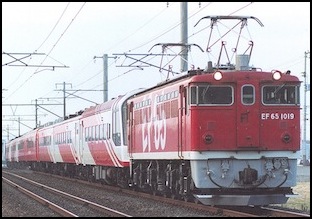
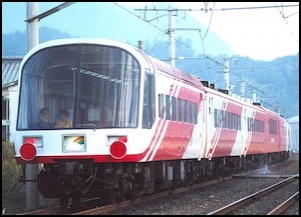
EF65-1019 pulling Super Express Rainbow (1989), and Super Express Rainbow (1989)
Photographer: spaceaero2 (both)
Nanohana (DC EMU, Tatami)
The Nanohana, built in 1986 (or 1985 per one page) for Japan National Railways (JNR) was the first EMU Joyful Train, although according to wikipedia there had been trainsets designated as Joyful Trains since 1961. It was built to operate in Chiba prefecture, on the Boso peninsula, and the paint scheme reflects this.
The Nanohana, and several other EMU sets, were built from retired 165 Series trains (Japanese Wikipedia), a DC-powered express EMU designed for the hilly Chūō Main Line and for cold-weather operation. It is described on both the English and Japanese wikipedia Joyful Train pages as being a tatami-mat train. The 165 was inherited and operated by JR East, JR Central, and JR West, and retired in 2003. The 165-based Joyful Trains were (per wikipedia) retired in 2001, and the Nanohana itself was retired in 1998, although a 485-based Nanohana (sometimes called “New Nanohana”, see below) is now in use.
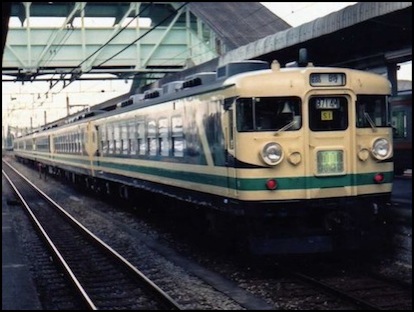
Nanohana, Shinmachi (1990)
Photographer: Cassiopeia Sweet
Panorama Express Alps (DC EMU, Conventional)
Introduced in 1987 and sold to Fuji Kyuko in 2001, this was another conventional-seating Joyful Train based on the 165 Series. Fuji Kyuko (which operates a rail line of the same name) used this for their Fuji Sun Express train, and thus it remains one of the few 165-Series trains in use (see also Japanese Wikipedia for Panorama Express Alps).
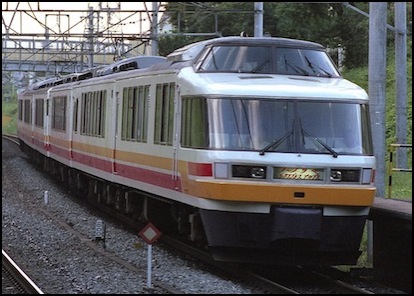
Panorama Express Alps, Shinmachi (unknown date)
Photographer: spaceaero2
Yu Resort Express (AC/DC EMU, Conventional/Tatami)
Introduced in 1988 (per JRE) or 1991 (per wikipedia) this was based on 183/189 stock, but is now classified as a 485. It has provision for being locomotive-hauled. This was originally equipped with conventional seating, rather than tatami-mat floors, but was apparently renovated in 1998 with cars (except for the dining car, or perhaps only the dining car) converted to use tatami mats. It is a six-car set.
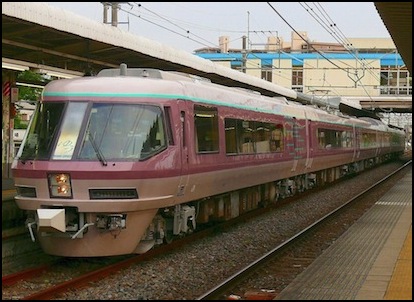
485 Yu Resort Express (2006)
Photographer: まも (Mamo)
Shuttle Maihama (DC EMU, Conventional)
This three-car train, equipped with ordinary seating, apparently of benches with backs that could be flipped depending on the direction of operation (and described as “vinyl leather”), was introduced in 1990, and was withdrawn in 1995. It was based on 165 Series equipment. It’s use appears to have been as some kind of shuttle associated with Tokyo Disneyland, rather than as a general-purpose Joyful Train. It was apparently converted to become the Joyful Train Alpha. (Japanese Wikipedia)
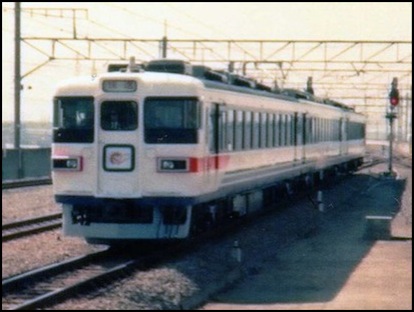
Shuttle Mihama at Nishifunabashi Station (1990)
Photographer: Cassiopeia_sweet
Sylphide (AC/DC EMU, European)
- Converted to NO.DO.KA in 2003
A three-car set based, at least in part, on the 485 (there are references to use of 183/189 stock also but it was apparently equipped for dual-voltage use). It was introduced in 1990, replacing an earlier “carpet train” (apparently based on DMU stock) and withdrawn in 2001. It was either originally or later converted to the tatami-mat form. The name references a wind spirit, from the ballet of the same name; in Japanese it is written “シルフィード”. The train appears to be equipped with a generator, allowing it to be locomotive-hauled on non-electrified lines. It was rebuilt to form the No.Do.Ka Joyful Train in 2001. (Japanese wikipedia)
There appear to be no available photos of this in the original paint scheme.
Utage (AC/DC EMU, Tatami)
This six-car tatami-mat train based on the 485 Series equipment was introduced in 1994, and remains in service as of 2009. It operates out of Oyama. The name Utage (“宴”) means “banquet” and the train includes a car with a tatami mat floor and a traditional (low) banquet table seating about 30. It may have been the first train with this design, although this is contradicted by references to the 1985 Nanohana and the 1988 Yu Resort Express being tatami-mat trains (however, the former could be confusion with the New Nanohana and the latter could have been converted later in its life).
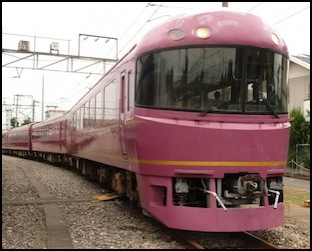
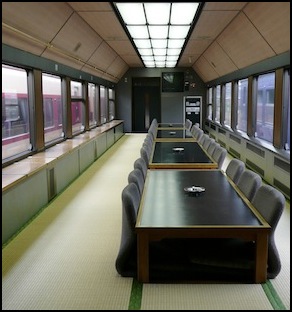
485 Utage (2006), and interior (2007)
Photographer: Rsa, and UE-PON2600
Joyful Train Alpha (DC EMU, Conventional)
This three-car set with conventional seating was built from the Shuttle Maihama set (and thus is based on 165 Series equipment). Introduced 1995, and apparently used in the Niigata region, it was withdrawn in 2001. (per Japanese Wikipedia for Joyful Train)
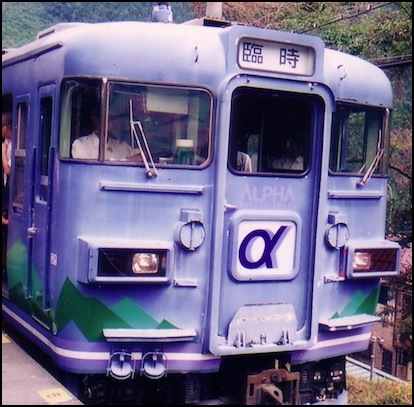
165 Alpha (2006)
Photographer: Rsa
Hana (AC/DC EMU, Tatami)
This six-car tatami-mat train based on the 485 Series equipment was introduced in 1997, and remains in service as of 2010. It operates out of Oyama.
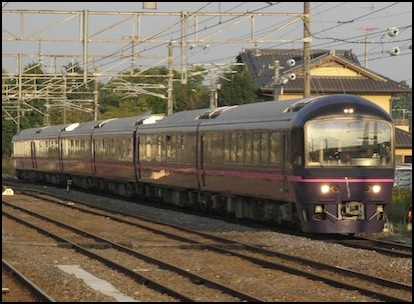
485 Hana (2007)
Photographer: TC411-507
New Nanohana (AC/DC EMU, Tatami)
This six-car tatami-mat train based on the 485 Series equipment was introduced in 1998, and remains in service as of 2009. It operates out of Makuhari and Chiba. Sometimes referred to as the “New Nanohana”, and sometimes simply as “Nanohana”, it replaced the earlier 165-based Nanohana.
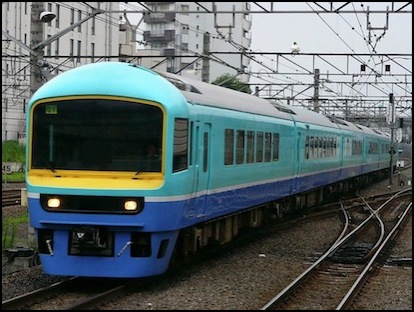
485 New Nanohana, Tachikawa, Tokyo (2003)
Photographer: Chabata_k
Yamanami (AC/DC EMU, Tatami)
This four-car tatami-mat train based on the 485 Series equipment was introduced in 1998, and remains in service as of 2010. It operates out of Takasaki.
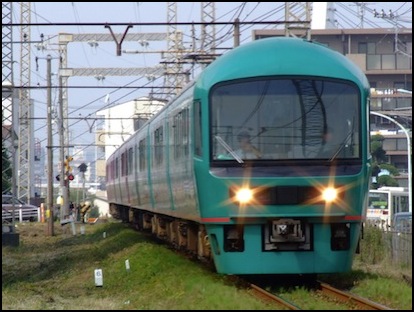
485 Yamanami (2006)
Photographer: LERK
Seseragi (AC/DC EMU, Tatami)
This four-car tatami-mat train based on the 485 Series equipment was introduced in 2001, and withdrawn in 2010, to be rebuilt as the Resort Yamadori. It had a top speed of 120 kph and a capacity of 116 (all per JRE). It operated out of Takasaki.
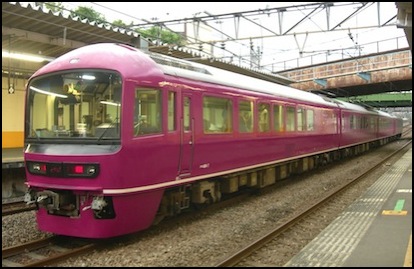
485 Seseragi (2009)
Photographer: Rsa
Shikisai (DC EMU, Conventional)
This four-car conventional-seating train based on the 201 Series equipment was introduced in 2001, and withdrawn in 2009 after being repainted in 2005. It had transverse seating and panorama windows on one side. It operated out of Hachioji and Tokyo.
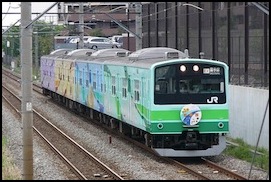
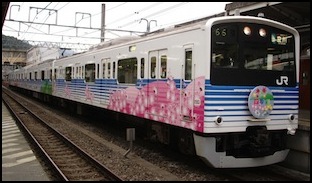
201 Shikisai in original livery at Kanagawa (2004), and new livery (2007)
Photographers: cory, and Rsa
NO.DO.KA (AC/DC EMU, European)
This train was created from the Sylphide and introduced in either 2001 or 2003 (sources vary, but the 2003 date is given on the Japanese Wikipedia page for the Sylphide). It appears that part of the conversion involved restoring it to the “carpet train” format.
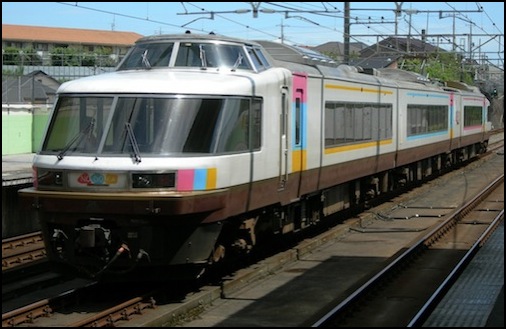
485 “NO DO KA” (2009)
Photographer: Rsa
Kirakira Uetsu(AC/DC EMU, Conventional)
- a.k.a. “Twinkle Uetsu”
This four-car conventional-seating train based on the 485 Series equipment was introduced in 2001, and remains in service as of 2009. It operates out of Niigata. It has a “counter-style teahouse” in one car. Per an older wikipedia entry this train is a Rapid, not a Limited Express, and operates along the Sea of Japan coast though Niigata. However, a JR East pamphlet (PDF) describes it as a “resort train” and it is now included on the Joyful Trains pages (both English and Japanese).
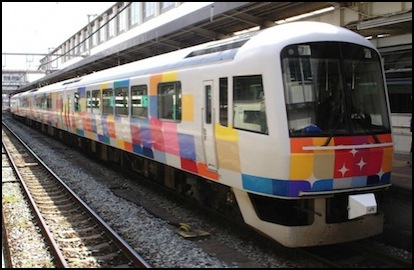
485 KiraKira Uetsu (2007)
Photographer: Rsa
Irodori (AC/DC EMU, Conventional)
This six-car conventional-seating train with compartments, based on the 485 Series equipment, was introduced in 2001, and remains in service as of 2006. It operates out of Nagano.
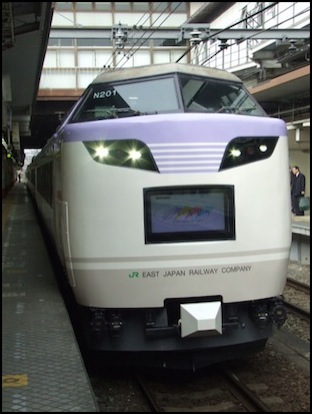
485 Irodori at Hachioji (2009)
Photographer: Lover of Romance
Ayano (DC EMU, Conventional?)
The Japanese name “彩野” doesn’t translate, but the phonetic equivalent Ayano is used on the photographs accompanying its Japanese Joyful Train Wikipedia entry and references in the Japanese 183 Series entry (see below). This six-car train, based on the 189 Series equipment, was introduced in 2003, and apparently remained in service as of 2010, although possibly it was transfered entirely to use on the Kinugawa resort train in 2006 or earlier. The equipment was scrapped in 2010.
It appears to have been repainted, and had the headlights removed for clearance reasons, when it was reassigned for Kinugawa use, but the text is unclear (it’s possible these are two different trains, an Ayano and an “Ayano assigned to Kinugawa express duty” train, but I don’t think so). It operated out of Omiya. The description in the Japanese Wikipedia entry for the 183 series suggests that the second version is the same as the original (although there’s some text that may say the motor systems were converted to be 485-series, but I think what it’s actually saying is that this equipment is a substitute for the better-outfitted 485 Series equipment usually used on Kinugawa service), and still known as the Ayano to JR East, although the Ayano marking has been painted out.
JR East classifies the Kinugawa service as a Limited Express, probably because it serves a fixed route: Nikkō, site of several important and popular shrines, and the Kinugawa onsen (hot springs) resort area, both on the Tōbu Kinugawa Railway line. See the description of the Kinugawa on the Resort Trains page for more information.
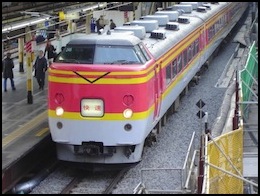
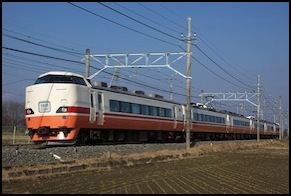
189 Ayano at Yokohama (2004), and 189 Ayano Kinugawa (2006)
Photographer: UE-PON2600, and Sui-setz
Nagomi (AC/DC EMU, Conventional)
- a.k.a. Imperial Train
Introduced in 2007, the sole E655 Series train, in its five-car version (without the car reserved for the Emperor’s use) is counted as a Joyful Train, named “Nagomi”, which translates as “to be calmed down” or “relaxed”, and is available for charters. It is equipped with diesel generators for locomotive-hauled use on non-electrified lines. It uses an aluminum double-skin construction, similar to the E257 and E653. The main train is operated out of Oku Depot, but the Imperial car is kept at the Tōkyō General Rolling Stock Center (Japanese Wikipedia) in Shinagawa, near Tōkyō Station and the Imperial Palace, when not in use.
With the Emperor’s car attached it is known as the Imperial Train. Since its introduction, it has been used only twice by the Emperor, who typically travels by Shinkansen or car. Kato makes a model of the five-car charter version, lacking the sixth car and the Emperor’s chrysanthemum seal placed on the nose when in Imperial service.
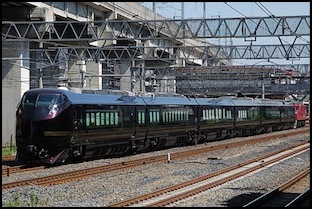
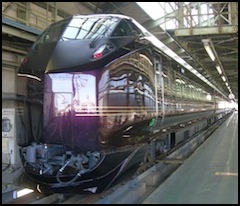
E655 Test Run with Imperial Car (2007), and E655 in Oku maintenance depot (2008)
Photographer: Sui-setz, and Rsa
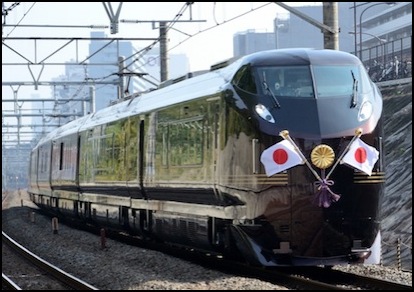
E655 in Imperial Service (2011)
Photographer: Tkwave
Resort Yamadori (AC/DC EMU, unknown)
Planned for introduction in 2011, based on a rebuild of the 485-Series equipment previously used for the Seseragi. It will be assigned to Takasaki according to Wikipedia.
No photo of this train is yet available.
JR West also operates a 485 Super Raichō train which has a “panorama” cab car on one end similar to the Yu Resort Express cab (and a “normal” 485 cab on the other end). It does not operate near Tōkyō.
Additional References
Some of the information provided here came from the Wikipedia articles linked above, while other details were compiled from print and web sources. Among these were:
Taking the Train in Japan, from Japan-Guide.com - A travel website with information about rail travel.
New Technologies for Railway Trains, Hitachi Review, Vol. 48 (1999), No. 3, pg. 134.
JR East’s list of Joyful Trains (Japanese website).
Japanese Wikipedia page for the Kira Kira Uetsu.
Japanese Wikipedia page for the Oku Vehicle Center.
Japanese Wikipedia page for Tokyo General Rolling Stock Center.




